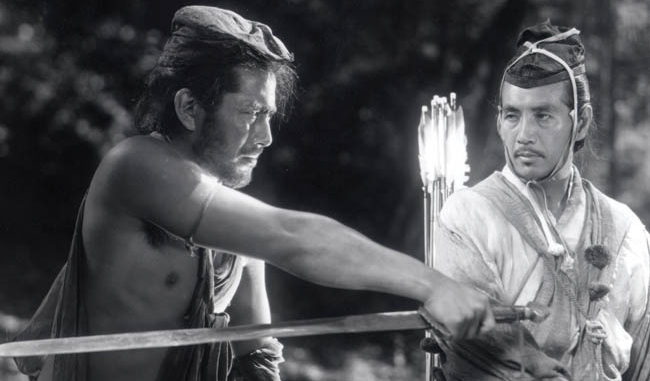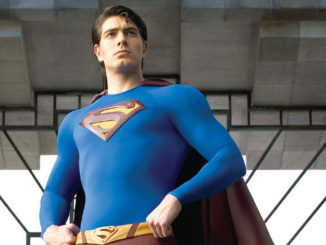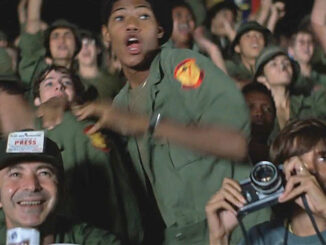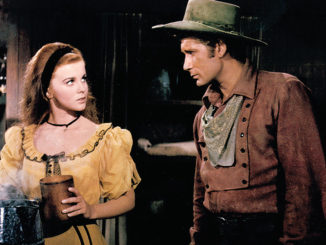
by Kevin Lewis
Howard Hughes created his own “Made in Japan” import when he bought Akira Kurosawa’s Rashômon for distribution through his RKO studio in 1950. Since then, the word “rashômon” has become part of the English-language lexicon denoting several versions of the same story according to one’s perceptions, omissions and evasions. The film won an Honorary Oscar for Outstanding Foreign Language Film in 1951 (a few years before the Academy instituted a classification for that award) and cemented Kurosawa’s reputation as an international filmmaker. Because of the film’s enormous reception in the United States, the reviled Japanese former empire became a world player in cinema.
When Rashômon premiered in Japan 60 years ago this August, it was exactly five years after the US-deployed atom bombs devastated Hiroshima and Nagasaki, ending the absolutism of Imperial Japan and World War II, creating the American occupation of Japan and laying the groundwork for the emergence of global economics through “Made in Japan” imports. Traditional Japanese fealty to a supreme monarch, who sanctioned kamikaze fighters in his name, was no more. Rashômon, a story about several untrustworthy versions of the same incident, is a metaphor for this changed Japan.
The American occupation under General Douglas MacArthur, called the Supreme Commander of Allied Powers (SCAP), re-organized the Japanese film industry under the Civil Information and Education Section (CIE) and instituted its own version of the Production Code. Films that dealt favorably with feudalism, the military and the imperial rule were banned. Allowed were domestic dramas, melodramas and film noirs––all Hollywood genres in which Kurosawa excelled because, as a boy in Japan, he saw many American silent movies, and loved William S. Hart’s Westerns and John Ford’s films. By Kurosawa’s own admission, Ford was his inspiration.
Like Ford, Kurosawa, who is the credited editor on Rashômon, edited his films in camera during production because he knew what he wanted on screen, and would edit the dailies after each shooting day. The most Westernized of his country’s contemporaries, Kurosawa emulated the American films that flooded the Japanese cinema after 1945––particularly the films of Frank Capra, Howard Hawks and, of course, Ford.
Critics at the time were shocked by the cinematography of Miyagawa Kazuo because he deliberately shot into the sunlight and created natural lighting patterns. That broke the rules of studio-bound cinematography.
Kurosawa admired silent film for its fluid technique, its pictorial beauty and its bold body language. Rashômon, which was based on two stories by the Japanese author Ryunosuke Akutagawa and adapted by Hashimoto Shinobu, offered him the opportunity to create a story in natural settings. “Since the advent of the talkies in the 1930s, I felt we had misplaced and forgotten what was so wonderful about the old silent movies,” Kurosawa wrote in his autobiography, Something Like an Autobiography, in 1983. “I sensed a need to go back to the origins of the motion picture to find this peculiar beauty again; I had to go back to the past.” He had said he wanted this film to be evocative of the French avant-garde films of the 1920s. “Rashômon would be my testing ground, the place where I could apply the ideas and wishes growing out of my silent film research.”
The director himself was emulated by generations of the new American cinema (George Lucas, Steven Spielberg, Francis Ford Coppola, Martin Scorsese and Sam Peckinpah), as well as the respective new cinemas of Germany (Werner Herzog), France (Alain Resnais), Italy (Sergio Leone) and Sweden (Ingmar Bergman).
Japan’s untrammeled forests of the mountains around Nara and the forest by the Komyoji Temple outside Kyoto were the locations used for the film. Rashômon is the gate to the Komyoji Temple. Except for the Rashômon gate, reconstructed in a studio, the film was shot outdoors and has a painterly en pleine air quality, which is one reason why it has a timelessness and sustains its metaphorical sensibility.
The two witnesses––a Buddhist priest who saw the couple shortly before the rape and murder, and the woodcutter who found the samurai lord’s body––ruminate to a stranger about their judical court testimony to the police. They relate the conflicting stories of the arrested wife, who claimed she was raped; the captured bandit, who claimed the woman consented to sex and ordered him to kill her husband; and the testimony of the murdered husband (through a medium), who claimed he committed ritual seppuku to save face. The rain at the Rashômon gate forces the priest, the woodcutter and the stranger to huddle together—and they find uncomfortable truths about themselves.
The flashback sequences in the open-air judicial court take place in the harsh sun with no furniture or setting, just the white earth. The rape, murder and suicide occur in a primeval forest on a sunny day with the foliage dappling light upon the earth, the lord, his wife and the bandit peacefully and serenely. Critics at the time were shocked by the cinematography of Miyagawa Kazuo because he deliberately shot into the sunlight and created natural lighting patterns. That broke the rules of studio-bound cinematography.
There is a certain irony in the fact that Kurosawa, the descendant of an old samurai family, spent much of his subsequent career glorifying the samurai code.
Perhaps one of the French avant-garde filmmakers Kurosawa admired was Jean Renoir, whom he knew. Renoir and his cinematographer brother used natural lighting in a similar fashion. Renoir himself was influenced by his father, the great Impressionist painter Pierre Renoir, who painted his non-portrait work in the open air (as did Monet) to replicate nature’s lighting.
The conclusion of the film is very Western. Its “All Men Are Brothers” message resonated in the post-war world after the atom bomb showed us that we are mere molecules who can be obliterated instantly. The priest tells the woodcutter and the stranger that he himself must believe in man, and trust between men, because without trust, the world would be hell. The woodcutter and the stranger are then revealed to be thieves, no different than the bandit. The former stole the pearl inlay short sword (the murder weapon) belonging to the wife, and the latter swipes the kimono from an abandoned baby at Rashômon gate. The woodman does redeem himself by taking the baby to raise with his children, so the priest’s hope for the world is vindicated.
For years, the rumor was that Japanese filmgoers shunned Rashômon, but Donald Richie, the leading expert on Japanese cinema, dispelled this idea in his book The Japanese Film: Art and Industry (1959). Richie mentions that the Japanese audiences expressed confusion because they needed to know who was telling the truth. So some Japanese cinemas “provided benshi-like explanations about the film,” referring to the Japanese tradition of performers providing live narration to silent films. Nonetheless, the film was the eighth-ranking box-office success of 1950 in Japan. And when Giuliana Stramigioli, the Japan representative of Italia Film, saw the film during its initial release, she recommended its submission to the Venice International Film Festival, where it won the Golden Lion and went on to world recognition.
There is a certain irony in the fact that Kurosawa, the descendant of an old samurai family, spent much of his subsequent career glorifying the samurai code in such classics as The Seven Samurai (1954; remade as The Magnificent Seven, 1960), Throne of Blood (1957), Yojimbo (1961; remade as A Fistful of Dollars, 1967) and Ran (1985). In addition, The Hidden Fortress (1958) was the acknowledged inspiration for George Lucas’ Star Wars (1977). Rashômon itself was remade unsuccessfully as The Outrage (1964). And Toshiro Mifune, who played the bandit in Rashômon, became such a star in these movies that he made the samurai a folk hero in American culture. Just what General MacArthur tried to avoid! p
Editor’s Note: To celebrate the centennial of the director, who was born in March 1910, the Criterion Collection has released a deluxe DVD box set, AK 100: 25 Films by Akira Kurosawa. Rashômon is also available in a newly restored version.





